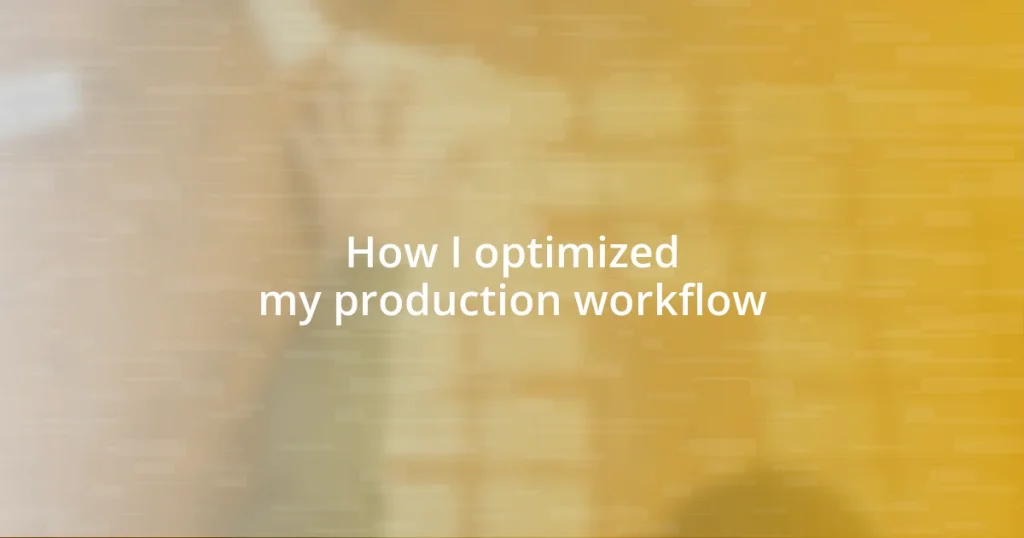Key takeaways:
- Mapping out production workflows and identifying bottlenecks through data analysis and team feedback enhances efficiency and productivity.
- Implementing automation tools can transform processes by freeing up time for creativity, while streamlining communication improves team coordination.
- Continuous optimization through feedback, celebrating small wins, and embracing technology fosters a culture of innovation and improvement within teams.

Understanding production workflow basics
Production workflow serves as the backbone of any successful project, ensuring tasks are completed efficiently and effectively. I remember a time when my team struggled with chaotic processes, and it felt overwhelming—like trying to navigate a ship in a storm without a map. Understanding the basics of how each step connects can truly transform that chaos into smooth sailing.
At its core, a production workflow is about identifying the sequence of tasks necessary to achieve specific outcomes. Can you think of a time when you tackled a project without a clear plan? I’ve been there, and it often leads to wasted time and confusion. By breaking down each stage—planning, execution, and review—it becomes easier to streamline efforts and enhance productivity.
When we map out a workflow, we can identify potential roadblocks before they become issues. I often find it fascinating how a simple visual representation can reveal so much. Have you ever drawn a flowchart to organize your thoughts? I did, and it changed everything for me—it’s incredible how clarity opens up new pathways for creativity and efficiency!

Identifying workflow bottlenecks
Identifying workflow bottlenecks can feel like detective work. In my experience, the first step is gathering data. I remember sitting down to analyze task completion times—some took way longer than expected, and I could almost hear the team sighing with frustration. It was a real eye-opener! When we listed out tasks and their durations, patterns emerged that helped us uncover where the slowdowns were happening.
Another effective method is soliciting feedback directly from team members. I’ve discovered that frontline employees often have the best insights into where delays occur. One day, during a candid team meeting, an employee pointed out that a particular approval step added unnecessary days to our process—all because of missing information. Listening to these voices can lead to significant improvements.
Lastly, utilizing workflow visualization tools can illuminate bottlenecks that aren’t immediately apparent. I once created a simple flowchart that mapped out our entire process, and I was amazed at how quickly we spotted unnecessary handoffs and redundant steps. Sometimes, a visual representation can change everything by making problems more visible and encouraging open dialogue about solutions.
| Identifying Bottlenecks | Insight |
|---|---|
| Data Analysis | Analyzing task durations reveals slow points. |
| Team Feedback | Frontline perspectives uncover hidden delays. |
| Visualization Tools | Flowcharts highlight redundancies and unnecessary steps. |

Analyzing production data effectively
Analyzing production data effectively is like piecing together a puzzle. Once, while sifting through performance metrics after a project, I felt a mix of curiosity and anticipation. Those numbers don’t just represent tasks; they tell stories of effort, bottlenecks, and success. I’ve learned that focusing on key indicators, such as lead times and output rates, can reveal valuable insights. This process doesn’t simply highlight trends; it unveils hidden opportunities for improvement. For instance, I noticed that a drop in output often correlated with specific times of day—leading me to adjust our schedules for optimal performance.
- Examine key performance indicators (KPIs) like lead times and output rates.
- Look for patterns and correlations in data—like time of day affecting productivity.
- Consider the human element; emotions and morale can impact data trends significantly.
Sometimes, it takes a different perspective to truly analyze data. I vividly remember a time when I thought I was focusing hard on efficiency, but I overlooked the team’s morale. After pulling together feedback, I discovered that long hours without breaks were consuming our energy and creativity. Turning those insights into actionable changes sparked a renewed enthusiasm within the team. That’s why it’s crucial to dig deeper than numbers—understanding the emotional context can make a substantial difference. When I embraced this holistic approach, the data transformed from mere facts to a narrative that guided our journey forward.

Implementing automation tools
Implementing automation tools can feel transformative. I remember the first time I integrated an automation tool into our project management process. Suddenly, routine tasks like status updates and reminders were handled with just a few clicks. I felt an immediate sense of relief and realization—this was the breakthrough we needed to free up time for creative problem-solving instead of being bogged down in minutia.
I found that there are tons of automation tools out there, but I recommend starting small. For example, I selected a tool that streamlined our email communications by automatically sorting and prioritizing messages. The first time I noticed a clutter-free inbox, I realized how much mental energy was drained by just managing emails. Isn’t it fascinating how technology can declutter our minds, allowing us to focus on what truly matters?
Moreover, I began experimenting with more complex automations, like linking our project management software to reporting tools. This integration not only delivered real-time updates but also eliminated the tedious task of manual reporting. I vividly recall sharing the first automated report with my team, watching their faces light up. The excitement was palpable; they were eager to dive into data without the hassle. This journey into automation reshaped our workflow, enhancing not just our efficiency but also our enthusiasm for projects.

Streamlining communication processes
Streamlining communication processes was a game changer for my workflow. I’ll never forget the moment I decided to switch from scattered email threads to a centralized communication platform. The chaos of constantly searching for replies and updates dissipated almost overnight. In a matter of days, the entire team felt more connected, and messages that used to get lost suddenly sparked vibrant discussions and quick decisions. Have you ever experienced that moment of clarity when everything just clicks? That’s how I felt.
I also paid keen attention to feedback loops within our communication. I initiated regular check-ins, which encouraged open dialogue about what was working and what wasn’t. One afternoon, during one such meeting, a team member shared their struggle with miscommunication on project timelines. That revelation prompted us to establish a clearer, mutual calendar where everyone could track progress. It was eye-opening—not just for me but for the whole team—to realize that sometimes, we just need to break down walls and voice our concerns. The impact was immediate; our productivity surged because we were all on the same page.
In my journey, I discovered that integrating visuals into our communication was equally vital. I started using digital whiteboards to sketch out ideas collaboratively, and I still remember the excitement in the room when we fleshed out a complex project visually. The energy shifted, and everyone became engaged participants rather than passive recipients of information. It made me wonder—how often do we overlook the power of visual communication? The transformation was remarkable, revealing insights that words alone often fell short of conveying. Every improvement reinforced my belief that communication isn’t just about exchanging information; it’s about connecting effectively.

Measuring workflow performance improvements
Measuring workflow performance improvements requires a careful evaluation of both quantitative and qualitative metrics. I remember the first time I embarked on this journey; I didn’t just want to see how much faster we completed tasks, but also how much more engaged and motivated my team felt. Analyzing feedback from team members through surveys revealed surprising insights—like an increased sense of ownership over their work, which I believe is just as important as deadlines being met.
One of the tools that proved invaluable in this process was a performance dashboard that tracked our key performance indicators. I still vividly recall the moment I first displayed it during a team meeting. The data was not just numbers—it was a story of our evolution. I encouraged my team to reflect: What did these trends say about our collaboration and abilities? These discussions often led to lightbulb moments, sparking new ideas for improvement and instilling a sense of collective accountability that I didn’t expect to see.
Additionally, I’ve learned the importance of celebrating small wins along the way. One instance stands out in my memory; after implementing a new task management system, we noticed a 25% reduction in time spent on revisions. That day, we made a point to celebrate—not just the time saved, but the creativity unlocked when our energy was freed from repetitive tasks. It made me think: How often do we truly acknowledge achievements, no matter their size? This practice of measurement and celebration helped us not only gauge progress but also fostered a culture of continuous improvement.

Continuously optimizing the production process
Continuously optimizing the production process feels like a never-ending journey, but it’s one that constantly fuels growth. I vividly recall a time when I realized that even minor adjustments could yield significant enhancements. After implementing a feedback system, I was pleasantly surprised to see my team actively suggesting changes to improve tasks. It made me wonder, how often do we recognize that our greatest resource lies in the insights of our own team members? By valuing their input, we unlocked a treasure trove of ideas.
As I delved deeper into optimization, I created a culture where experimentation was not only encouraged but celebrated. I still remember the excitement the team felt when we introduced a trial period for new tools and processes. One particular instance stood out: after testing a new resource allocation method, we achieved remarkable efficiency gains. Reflecting on that moment, I thought, how amazing it is to witness the eagerness of a team empowered to innovate, each member knowing their voice matters.
The role of technology in streamlining our production process cannot be overstated. I learned that automating repetitive tasks transformed the work environment dramatically. I recall the first time I automated our reporting functions; my colleagues had more time to focus on strategic projects rather than getting bogged down in administrative tasks. It made me realize: what possibilities could we explore if we freed ourselves from manual drudgery? This constant evolution not only optimized our workflow but also revitalized our creativity, reinforcing the endless potential of refining our production processes.















